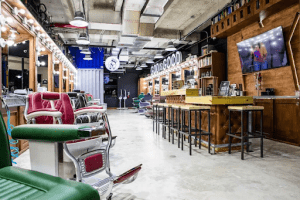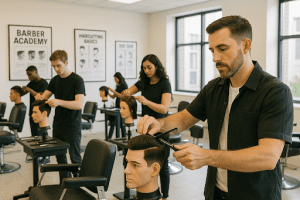Introduction
Starting a career in barbering is an exciting venture that transforms an interest in men’s grooming into a skilled profession. If you’re exploring options for a “barbering training program” or searching for a “barbering program near me” in Miami, you’ve probably stumbled across countless questions: What will I learn? How long will it take? Can I earn hands-on experience before graduation? Many Miami barber academies also operate free haircut programs, where students practice on real clients while offering complimentary services to the community. This comprehensive guide addresses the most frequently asked questions about barber school, sheds light on free haircut initiatives, and equips you to select the ideal training path in Miami—never naming a specific institution, but giving you the tools to decide wisely.
What to Expect in a Barbering Training Program
A thorough barbering training program blends classroom theory with hands-on practice. Understanding each component helps you know what to look for when you search “barbering training program” online.
Technical Skills Development
Mastering cutting and styling techniques starts with practicing on mannequins and peers, then progresses to real clients. You’ll learn how to handle clipper attachments for fades, tapers, and guard lengths; work with shears and thinning scissors for precision cuts; perform straight-razor shaves including hot towel prep and beard shaping; and execute styling methods like blowouts, product application, and finishing touches.
Safety and Sanitation
Barber professionals uphold strict cleanliness standards to protect clients and themselves. Training covers tool sterilization (Barbicide dips, UV cabinets, ultrasonic cleaners), workstation hygiene (surface disinfection, proper trash disposal, clean uniforms), and personal protective equipment such as gloves, masks, and single-use items.
Skin and Hair Science
Lessons in anatomy and chemistry deepen your expertise: hair structure (cortex, cuticle, medulla), common scalp conditions (dandruff, dermatitis, folliculitis), and product chemistry (how oils, gels, and clays affect hair and skin health). This knowledge enables tailored recommendations, enhancing client satisfaction.
Business Essentials
Running a successful barber chair requires more than sharp scissors. Look for programs that teach client management (booking systems, consultation techniques, retention strategies), retail sales (advising on aftercare products without pressure), and personal branding (social media portfolios, referral programs, local networking).
Licensing Preparation
In Florida, barber licensing demands both written and practical examinations. High-quality programs provide mock practical exams under timed conditions, theory review sessions covering state statutes, sanitation rules, and anatomy, plus one-on-one mentoring to shore up any weaknesses.
Benefits of Choosing a Barbering Program Near Me in Miami
Searching for “barbering program near me” in Miami unlocks distinct advantages tied to the city’s vibrant culture and industry pulse.
- Exposure to Diverse Hair Types
Miami’s multicultural population presents everything from tightly coiled Afro-textured hair to ultra-fine straight styles. This breadth of experience sharpens adaptability and marketability.
- Direct Networking
Local events—pop-up shops, barber conventions, and street fairs—offer chances to connect with master barbers, product reps, and potential clients. Face-to-face networking accelerates your career jumpstart.
- Trend Leadership
Known for setting style trends, Miami keeps barbers at the forefront of men’s looks—from skin fades and pompadours to intricate clipper art. Training here ensures cutting-edge skills.
- Convenience and Savings
Choosing a nearby academy cuts commute time and costs, letting you dedicate more energy to mastering techniques and participating in extra clinic hours.
- Community Engagement
Miami-area barbering schools often partner with shelters, veterans’ groups, and nonprofits to provide free haircut programs. Getting involved deepens your skills while giving back.
Common Questions About Barber School in Miami
What Does the Curriculum Cover?
Typical modules include haircutting techniques (all guard lengths, clipper-over-comb, shear cutting), shaving services (hot towel prep, straight-razor control, beard differentiation), styling basics (product chemistry, blow-drying, finishing), sanitation and safety (disinfection, tool storage, hygiene protocol), anatomy and physiology (hair growth cycles, scalp health, skin conditions), business practices (retail sales, marketing, client retention), and licensing prep (state board regulations, mock exams, paperwork guidance). A balanced schedule splits time between lectures, mannequin work, and student-operated clinics.
How Long Does Training Take?
Florida requires 600 clock hours for barbering. Full-time students typically finish in 6–9 months, while part-time or evening programs may extend to 12–18 months. Your personal timeline depends on weekly class hours, holiday breaks, and any additional electives you choose.
What Are the Admission Requirements?
You’ll generally need a high school diploma or GED, meet the minimum age requirement (usually 16 or 17), provide government-issued ID and proof of Florida eligibility, submit health records (immunizations or recent physical exam), and undergo a brief entrance interview to assess fit and commitment.
How Much Does Barber School Cost?
Tuition ranges from approximately $6,000 to $14,000, inclusive of kits, textbooks, and exam fees. Many schools offer payment plans, scholarships, and veteran benefits. Always request a detailed breakdown of tuition, fees, and refund policies before enrolling.
Will I Get Real-World Practice?
Yes. Most barbering academies host student clinics open to the public or run a free haircut program where learners offer complimentary services under instructor oversight. This setup provides authentic client interaction, builds confidence, and generates portfolio photos and testimonials.
What’s on the State Licensing Exam?
Florida’s barber exam includes a written theory section with multiple-choice questions on sanitation, anatomy, and regulations, plus a practical skills test involving haircutting, shaving, and chemical services on mannequins or live models. Seek programs with high pass-rate records and robust exam-prep support.
What Career Opportunities Exist After Graduation?
Graduates may work as traditional barbershop stylists, men’s grooming specialists in upscale salons or resorts, mobile barbering entrepreneurs, barber educators, or even shop owners with initial business training.
The Free Haircut Program: Learning Through Service
Many “barbering program near me” searches uncover a hidden gem—free haircut initiatives that fuse student training with community outreach.
How the Program Operates
Appointments serve low-income families, veterans, seniors, and youth groups via partner nonprofits or direct sign-ups. Students perform haircuts, shaves, and styling under close supervision, while instructors ensure client comfort and proper technique. Clients complete brief surveys assessing punctuality, communication, and quality, creating a feedback loop that accelerates improvement. Licensed barbers sign off on every service, upholding consistency and safety.
Benefits for Students
Students refine skills on diverse hair textures, develop soft skills like client rapport and upselling, build a portfolio of before-and-after photos, and earn a reputation as community-focused professionals.
Benefits for the Community
Free haircut programs provide access to grooming services for those who might otherwise skip them, boosting confidence, dignity, and social engagement. Partnerships with shelters, retirement homes, and youth centers strengthen local networks.
Finding the Right Barbering Training Program in Miami
Use this checklist to narrow down choices:
- Accreditation & Approval
Verify standing with the Florida Board of Barbering and national accreditors such as NACCAS.
- Curriculum Transparency
Request detailed syllabi showing clock-hour splits among theory, mannequin practice, and live clinics.
- Instructor Qualifications
Look for active barbers with multiple years of field experience and teaching credentials.
- Facility Tour
Examine cleanliness, equipment quality, and the brands of clippers, shears, and styling tools available.
- Class Size & Schedule Flexibility
Smaller cohorts allow personalized coaching; check for day, evening, and weekend sections that suit your lifestyle.
- Student Support Services
Career counseling, interview prep, and portfolio workshops can accelerate your job search.
- Alumni Outcomes
Ask for graduation rates, board pass rates, and local placement statistics. Proven results signal quality.
- Financial Aid Options
Compare scholarship awards, grant opportunities, and interest-free payment plans. Transparency prevents surprise fees.
Preparing for Barber School Success
Acquire Basic Tools Early
Although many programs include starter kits, sourcing high-quality clippers, guards, shears, razors, strops, combs, brushes, and capes in advance smooths your transition.
Build Foundational Knowledge
Familiarize yourself with cutting terminology (fade, taper, crown, neckline), anatomy basics (hair growth cycles, scalp conditions), and sanitation laws via online tutorials and barbering textbooks.
Cultivate a Professional Mindset
Punctuality, respectful communication, neat attire, and mindful posture develop early good habits. Treat every mannequin like a real client.
Time Management
Use digital planners or calendars to block study sessions, clinic hours, and downtime, balancing education with personal life.
Funding Your Barber Education
Covering tuition need not stall your career dreams. Explore funding sources:
Federal and State Aid
Complete the FAFSA to qualify for Pell Grants, Stafford Loans, and state workforce vouchers.
Private Scholarships
Industry groups, nonprofits, and alumni associations award scholarships based on merit, need, or demographic focus.
Payment Plans
Many schools offer in-house interest-free installments or partner with third-party lenders to spread costs over 6–12 months.
Veteran Benefits
Service members may use the GI Bill or Veteran Readiness and Employment programs for tuition and housing stipends.
Work-Study and Campus Jobs
On-campus roles—reception, tool sterilization, social media management—let you earn while staying immersed in your training environment.
The Community Impact of Free Haircut Initiatives
Free haircut programs transform neighborhoods by:
- Boosting confidence for job seekers, students, and seniors.
- Bridging service gaps for low-income residents, ensuring basic grooming needs are met.
- Fostering social bonds between students, clients, and local organizations.
- Inspiring civic engagement as students continue volunteerism post-graduation at charitable events and fundraisers.
Real-Life Success Stories from Barbering Academies
Graduate A completed a nine-month barbering program, devoted clinic hours to free haircut events, and secured a downtown position within weeks of passing the state board exam—crediting community practice for their interview confidence.
Graduate B balanced evening classes with daytime work, used academy career services to craft a standout resume, and launched a mobile barber service specializing in senior home visits, bolstered by client testimonials from free-cut events.
Graduate C attended part-time classes to accommodate family obligations, gained crucial live-client experience through the free haircut program, and now mentors newcomers in the same academy clinic two years later.
These accounts illustrate how comprehensive training combined with community service and career support sparks rewarding barbering careers.
Tips for Maximizing Your Barber Education
- Practice Relentlessly
Schedule extra mannequin work or partner cuts to build speed and precision.
- Invite and Apply Feedback
Seek critiques from instructors and peers; record sessions to self-evaluate.
- Curate a Professional Portfolio
Photograph each client (with consent) and assemble digital galleries that attract post-graduation clients.
- Stay Current on Trends
Follow leading barbers online, subscribe to grooming journals, and attend trade shows.
- Hone Soft Skills
Master active listening, conversational rapport, and subtle upselling techniques.
- Network Continually
Join barber forums, attend meetups, and volunteer at community events to build industry connections.
- Invest in Continued Learning
After licensing, pursue specialty workshops—clipper art, advanced fades, beard design—to stand out.
Conclusion
Embarking on barber school marks the first snip toward a dynamic, creative career. When you search for a “barbering training program” or “barbering program near me” in Miami, prioritize accredited curricula, hands-on learning, experienced instructors, and robust career support. Free haircut programs offer invaluable real-world practice while strengthening community ties. By researching licensure requirements, exploring funding options, and preparing mentally and logistically, you’ll maximize your chances of success. Your transformation from novice to confident professional starts with that first lesson—so schedule your visit, tour the facilities, and take the leap into the barbering world today.




